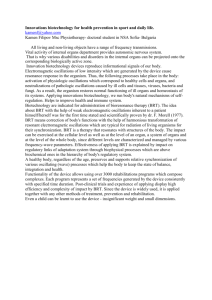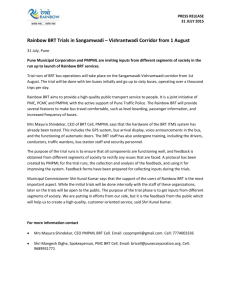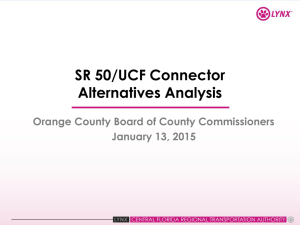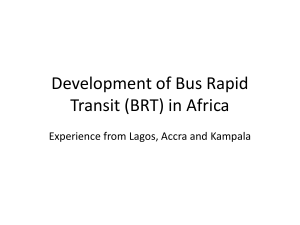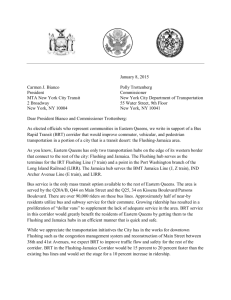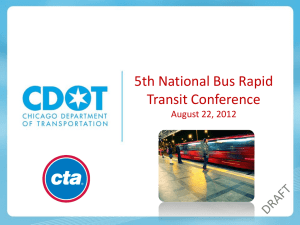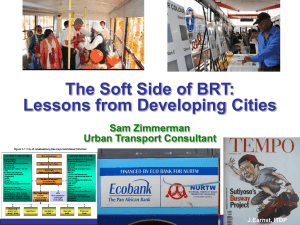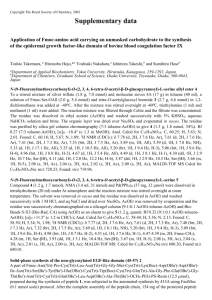Chapter 10_FINAL_DP_HL_InDesign Final
advertisement
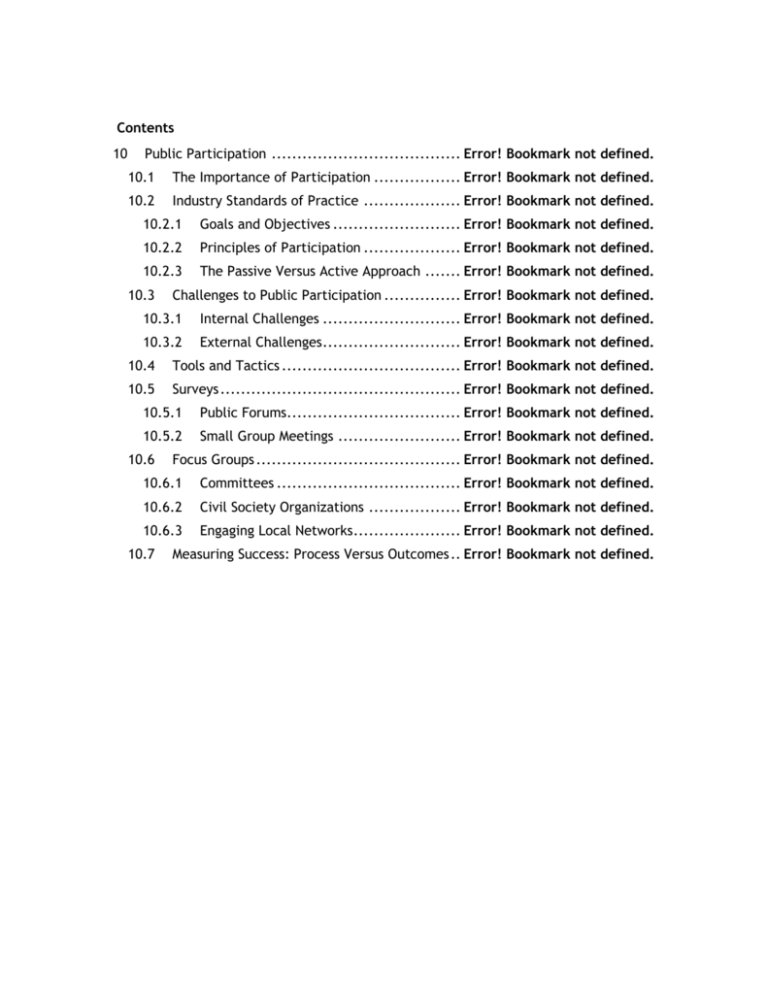
Contents 10 Public Participation ..................................... Error! Bookmark not defined. 10.1 The Importance of Participation ................. Error! Bookmark not defined. 10.2 Industry Standards of Practice ................... Error! Bookmark not defined. 10.2.1 Goals and Objectives ......................... Error! Bookmark not defined. 10.2.2 Principles of Participation ................... Error! Bookmark not defined. 10.2.3 The Passive Versus Active Approach ....... Error! Bookmark not defined. 10.3 Challenges to Public Participation ............... Error! Bookmark not defined. 10.3.1 Internal Challenges ........................... Error! Bookmark not defined. 10.3.2 External Challenges ........................... Error! Bookmark not defined. 10.4 Tools and Tactics ................................... Error! Bookmark not defined. 10.5 Surveys ............................................... Error! Bookmark not defined. 10.5.1 Public Forums.................................. Error! Bookmark not defined. 10.5.2 Small Group Meetings ........................ Error! Bookmark not defined. 10.6 Focus Groups ........................................ Error! Bookmark not defined. 10.6.1 Committees .................................... Error! Bookmark not defined. 10.6.2 Civil Society Organizations .................. Error! Bookmark not defined. 10.6.3 Engaging Local Networks ..................... Error! Bookmark not defined. 10.7 Measuring Success: Process Versus Outcomes .. Error! Bookmark not defined. 10 Public Participation Tell me and I’ll forget. Show me and I’ll remember. Involve me and I’ll understand. —Confucius, philosopher, 551–479 BC In Chapter 9: Strategic Planning for Communications, we reviewed stakeholders and target groups, and how they should be considered as part of your overall communications strategy. A comprehensive communications plan facilitates the interaction between project leaders and the stakeholders, including transport providers, passengers, and the general public. It is also a helpful tool for reviewing entrenched ideas and perceptions of public transport. This chapter takes a more in-depth look at public participation and the outreach necessary to achieve it, reviewing research on participation methods, tools and tactics, and desired outcomes. The purpose of this chapter is to highlight the importance of participation and engagement as strategies for BRT realization and success and to offer some best practice guidance for effecting a participatory process. Participation as a whole is more than “information-sharing,” “communication,” or “marketing,” although a well-thought-out strategy will integrate all these elements. Public participation in the transportation field is the process through which transportation agencies inform and engage people in the decision-making process. The benefits of engaging the public include community ownership of policies; better, more informed decisions that are sustainable, supportable, and reflect community values; increased agency credibility; and faster implementation of plans and projects. The most effective transport planning draws on specific insights from the public, civic organizations, existing operators, private sector firms, and other government entities to complement the knowledge of planning staff and consultants. To achieve community ownership of the project, BRT proponents must engage with people’s needs, fears, and interests. Public input on corridors and feeder services can be invaluable, as can insights from existing transport operators. Moreover, incorporating public views on design and customer service features will help ensure that the system will be more fully accepted and utilized by the public. Fig. 10.1 A stakeholders meeting in Rio de Janeiro, Brazil. Image courtesy of ITDP. 10.1 The Importance of Participation We always hear about the rights of democracy, but the major responsibility of it is participation. —Wynton Marsalis, trumpeter and composer, 1961Early development and implementation of a formal strategy addressing the spectrum of stakeholders and their concerns are fundamental to the success of BRT. The best participation strategies are built on the strengths of the situation on the ground and develop a widespread sense of project ownership while managing resistance to change. When done well, this will enhance the legitimacy of the project by providing stakeholders with a sense that they are being listened to, and it will improve the quality of the decisions made by the public transport agency, as they will better reflect the interests of the general public. In most countries, transport-system management suffers from some form of bias. Planners are primarily professional men from twenty-five to fifty-five years of age, who often do not use the public transport systems they are creating, and lack both firsthand knowledge and credibility with many stakeholder groups. This can lead to a biased system design, focusing on just one kind of commute that benefits professional adults working standard business hours, but excludes students, parents with small children, the elderly, the disabled, people who use the system for shopping and may have large bags, workers with their tools, or people who combine multiple errands such as work, shopping, and child care into one trip, also known as trip chaining (discussed in more detail in Chapter 4: Demand Analysis and Chapter 6: Service Planning). Proper management of stakeholders and public involvement increases the chances of a project’s success because they result in improved understanding of issues on the part of proponents and increased buy-in and appreciation among other stakeholders. Although agencies sometimes fear that participation could exacerbate the disapproval of a service, the reality is that a well-developed participatory strategy will bring people on board—literally and figuratively. Participation should be seen as a longterm strategy that can provide: Useful instruments for framing BRT positively, getting it on public agendas, and keeping it there for the time necessary for successful implementation; Knowledge and support for BRT among the key stakeholders and target groups, including opinion leaders and politicians; Crucial input regarding users’ needs and preferences that can offset age, ethnic, socioeconomic, and gender biases, often built into the urban transport planning system; Innovative perspectives that can enhance the usefulness and public perception of existing and new BRT routes, often based on relevant experiences from walking and cycling advocacy networks; Credible citizens’ initiatives and organizations capable of advocacy, education, campaigning, and other work to build and maintain long-term support for BRT. To optimize these potential contributions, the project’s management will need to take an “integrative approach,” weaving together the input received from an array of engagement venues. Specific activities include traditional approaches based on one-off events (public hearings, formal and informal consultations, surveys, and focus groups) as well as methods based on civil society initiatives, which typically involve activities like campaigning, education, organization-building, and other initiatives. For an innovative approach like BRT, building support among residents contributes substantially to putting it on public agendas and keeping it there throughout the typical turbulence of implementation. Citizens involved in participatory events can offer uniquely detailed, contextual knowledge of the urban spaces (and life systems) that are in design or under intervention. Moreover, in rapidly democratizing societies, their opinions influence politicians. Finally, citizens’ organizations are able to contribute crucial BRT-related information in a timely and credible way through a vast network of contacts. For example, a participatory process that creates a very BRT-literate neighborhood association executive enables that person to become an effective conduit as well to his/her local religious institution, health clinic, planning advisory board, or parents’ group at the local school. Table 1: Factors influencing Goals and Objectives of Participation Factor Observations Political Priorities Support through participation may focus on breadth—lots of people across different constituencies—or depth, key spokespeople willing to support, or a combination of both. Agency Priorities Keeping these in line with current and potential users’ preferences can save money and reduce risks. Level of Controversy Thinking outside the box, consultation, and bringing key citizens’ groups on board can help improve a difficult decision or build a better understanding of it. Reducing Risk Exposure Participation helps to “learn from the future as it emerges.” Project Schedule Participation can reduce delays due to unforeseen controversies or barriers. Environmental Justice Issues A legal requirement in the United States, other cities should still consider them as they influence perceptions of BRT. Safety Issues Detailed knowledge from citizens of their micro-environments can avoid costly errors and loss of lives. Legal Requirements It helps if participatory requirements are built into laws and regulations, so all companies are subject to the same rules. Source: Giering 2011 Fig. 10.2 Building support among residents and customers paid off well for Mexico City’s Metrobús BRT, which has enjoyed popular support during major expansions. Image courtesy of ITDP. 10.2 Industry Standards of Practice Those are my principles, and if you don't like them...well, I have others. —Julius Henry "Groucho" Marx, comedian and actor, 1890–1977 Public participation strategies are as diverse as the communities, locations, and agencies they serve. Specific public involvement techniques and the methods by which public transport providers execute public involvement strategies are constantly evolving. There are, however, some overall generalizations about the elements of agency public participation strategies and the process for creating them. Although this chapter focuses primarily on agency-government-user/civil society interactions, the principles of participation outlined here apply to other stakeholders including operators and drivers (addressed more comprehensively in Chapter 16: Vehicle Operator Contracting and Industry Transition). Governments, private sector, and civil society actors have diverse and sometimes contradictory views of what citizen participation in urban transport planning should be. Maximizing success in participation requires a fundamental shift from viewing public engagement and participation as an obligation to understanding it as an opportunity to improve and build the short- and long-term viability of the system. A well-designed participatory process can also strengthen the long-term credibility and viability of organizations that build civil society. Fig. 10.3 This design charette in Rio de Janeiro brought together government, civil society, and private sector representatives in preparation for the TransOeste BRT. Image courtesy of ITDP. 10.2.1 Goals and Objectives Just as in communications planning, goals and objectives play a key role in public involvement strategies. They guide the entire process, influencing who will be engaged, the level of participation desired, the type of information that will be needed, and the techniques to be used. Goals and objectives also set expectations about what the public participation effort will achieve and provide a basis for measuring outcomes. The goals themselves should be based on the specific needs of the project. What are the questions that need to be answered? What are the missing pieces of information? What type of public buy-in is desired? Below are common project-specific goals from the International Association of Public Participation. Inform: To provide the public with balanced objective information to assist them in understanding the problems, alternatives, opportunities, and/or solutions; Consult: To obtain feedback on analysis of alternatives and/or decisions; Involve: To work directly with the public throughout the process to ensure that public concerns and aspirations are consistently understood and considered; Collaborate: To partner with the public in each aspect of the decision, including the development of alternatives and the identification of the preferred solution; Empower: To place final decision making in the hands of the public (IAP2 2010). As with communications planning, each goal should be followed by specific, measurable objectives. For more information on defining goals and objectives, see Chapter 9: Strategic Planning for Communications. 10.2.2 Principles of Participation An essential part of having a well-designed participatory process is setting clearly defined principles that all participants agree to abide by, which are enforced by leaders or coordinators of participant groups. The Community Development Society (http://www.comm-dev.org) suggests the following five principles of good practice in community development: 1. Promote active and representative participation toward enabling all community members to meaningfully influence the decisions that affect their lives. 2. Engage community members in learning about and understanding community issues, and the economic, social, environmental, political, psychological, and other impacts associated with alternative courses of action. 3. Incorporate the diverse interests and cultures of the community in the community development process; and disengage from support of any effort that is likely to adversely affect the disadvantaged members of a community. 4. Work actively to enhance the leadership capacity of community members, leaders, and groups within the community (so that they may be ambassadors for BRT). 5. Be open to using the full range of action strategies to work toward the long-term sustainability and well-being of the community. There are many versions of these good practice principles, and they may be adjusted for local context and to address specific concerns. Fig.10.4 A community workshop in Rio de Janeiro, Brazil, asked participants to give input on the future of transportation in their city. Image courtesy of ITDP. 10.2.3 The Passive vs. Active Approach In the past, agencies have offered suggestion boxes, toll-free telephone numbers, leaflets, or advertising campaigns as examples of “participation.” While these offerings are not without value—high-quality collateral and information is a precondition for participation—they do not constitute a participatory process. Public transport providers must often make complex decisions about the type and amount of information to provide to the public, balancing the risks of providing too little information and too much. This can be further complicated by the often technical nature of the data and the risks of it being confusing or misinterpreted. However, information sharing is important not just for meaningful public involvement, but also for building trust within the community, creating transparency at the agency, enhancing advocacy efforts, and proactively guiding the public conversation instead of allowing others (including the media or other stakeholders) to dominate the debate. Equally important for shaping the public involvement process is the agency’s determination of what information it wants from the public. The survey results support the idea that for public transport providers, public involvement provides the agency with critical missing information. When asked about the type of input agencies typically want from the public, respondents noted that they want to know about community issues that might impact public transport service, as well as chronic customer service problems. Fig. 10.5 Surveys, which are discussed in more detail in Chapter 9: Strategic Planning for Communications, are an important and simple way to begin public outreach. Image courtesy of ITDP. Fig. 10.6 Results from an interview of thirty public transport providers about the type of input agencies typically wanted from the public. Graph courtesy of Transportation Research Board. Informational campaigns take place along a spectrum. At one end, you have one-way communication, which means providing information, usually to a broad public with no ability to receive feedback from the audience. This is what is known as a “passive approach.” Further along the spectrum are limited two-way communications processes, such as feedback surveys or Internet voting on preferences, which tend to be more sophisticated and have more of an impact on people’s thinking, although usually not on their behavior. At the other end, you have a genuine participation process or an “active approach” that involves more complex two-way or multi-directional communication, usually referred to as deliberation. Fig. 10.7 A passive approach to participation as information versus an active approach, where bidirectional communication, feedback and change foster optimum results. Developed by Carlos Felipe Pardo and Lake Sagaris. Generally speaking, the more active the approach, the better the results. For example, in deliberation, groups are engaged in an intense form of facilitated communication meant to bring crucial information to the surface, including the participants’ knowledge, interests, feelings, and fears. In the urban sphere, deliberation occurs in formal or informal spaces as preferred so people can hammer out agreements in a more relaxed, trusting environment. It can involve being active in the spaces being planned by conducting walking, cycling, or neighborhood access audits and reviews. This should happen in planning phases and be facilitated by the BRT team in conjunction with community groups. A well-organized participation process can transform people’s thinking and, more important, their actions. 10.3 Challenges to Public Participation We are like islands in the sea, separate on the surface but connected in the deep. ―William James, philosopher and psychologist, 1842-1910 Public transport providers face many challenges when engaging the public. These challenges arise from specific issues within the agency, such as inadequate resources, or from the public, such as feelings of cynicism and distrust, lack of time, and lack of awareness. These challenges are magnified when trying to engage traditionally hard-toreach populations such as people with limited language proficiency and low-income and minority communities. Responses to these challenges have varied among agencies, as has their success at rising above them. What has worked for some agencies has not always worked for others; however, many have been successful and there are common themes that have tended to lead public transport agencies to greater success in public involvement (TCRP Synthesis 89—Public Participation Strategies for Transit: A Synthesis of Transit Practice. Transportation Research Board. 2011): The more public involvement, the more likely an agency is at having successful outcomes; Determining the “right” questions to ask is important; Dedicating resources to public participation is important, but these do not have to be strictly financial resources; The value that an agency places on public involvement is critical to success; Openness and transparency matter, and in many cases are the most important as far as the public is concerned; Understanding, partnering with, and empowering communities can significantly benefit public involvement efforts and the agency. Fig. 10.8 Proposed increases in bus fares led to violent protests in Quito, Ecuador. Image courtesy of Diego Pallero, El Comercio. 10.3.1 Internal Challenges A survey by the Transportation Research Board in 2011 showed that the biggest internal challenges to public participation are inadequate financial and staff resources, difficulty in getting elected officials interested, and lack of time for public participation. Other challenges included lack of support from upper management, lack of public involvement training for staff, and lack of coordination among agencies. Fig. 10.9 Average transit rating of internal challenges for public involvement. Note: Average rating of responses where: “Not Significant” = 1, “Somewhat Significant” = 2, “Moderately Significant” = 3, “Very Signficant” = 4, and “Highest Significance” = 5. Graph courtesy of Transportation Research Board. A lack of resources is almost always a major challenge for public transport agencies. However, there are many ways to ensure successful public involvement that can be done with a modest budget. The best way this can be managed is to integrate public engagement into all of the agency’s public transport activities, rather than rely on a separate budget. Even informal conversations among drivers, riders, agency staff, and community members all provide important information that can be taken back to the agency. Building partnerships with community organizations can also address the resource problem. It is an effort that takes time and commitment, but it can reap rewards for an agency in both the short and long term. For the Hiawatha LRT project in Minnesota, USA, the Metropolitan Council reimbursed community organizations for costs associated with distributing information about the project, an action that saved the agency money (e.g., labor costs) and allowed it to tap into local distribution channels. Maintaining these relationships rather than having to rebuild them for each project will also provide efficiencies for future efforts. Most of the other internal challenges have to do with the failure to prioritize public participation in the overall BRT process. This is a common problem that does not have a simple answer. We recommend that public participation plans be built into the system planning from the outset, including in the very first funding proposal (see Chapter 9: Strategic Planning for Communications on the importance of public participation). 10.3.2 External Challenges There are many complex challenges to overcome in managing external stakeholders, such as feelings of cynicism and distrust, lack of time, and lack of awareness. Agencies are best able to succeed when they (1) have taken the time and effort to understand the challenges and their causes; (2) have a firm understanding of community issues, needs, and local support networks; and (3) approach projects and planning efforts in a collaborative fashion with communities. Public cynicism and distrust of the process can arise from a feeling that participation is not worth the effort—that decisions have already been made and the opportunity for public input is merely a formality. Overcoming these feelings among the public requires building trust within the community. The best way to counteract this is by being as open and transparent as possible. Some agencies have found that by structuring public meetings to allow participants to work through and identify solutions to specific problems, they have helped participants feel as though they have a meaningful impact on the planning process. In addition, demonstrating exactly how public involvement is used to inform the planning process can reduce levels of distrust. All opportunities for public involvement must compete with the other obligations of people’s lives. Finding time to participate in a community meeting is not generally high on the list of priorities for working people. Providing multiple opportunities for participation, including outside of regular business hours, and offering opportunities that are not dependent on time and place, such as online and mobile engagement, can help increase participation levels. In addition, active engagement, such as going out and meeting people where they are, is essential. These are discussed later in this chapter. Lastly, making your financial information and audits available for public review demonstrates that you can be trusted with public funds. Fig. 10.10 Average transit rating of external challenges for public involvement. Note: Average rating of responses where: “Not Significant” = 1, “Somewhat Significant” = 2, “Moderately Significant” = 3, “Very Signficant” = 4, and “Highest Significance” = 5. Graph courtesy of Transportation Research Board. 10.4 Tools and Tactics Do not wait; the time will never be 'just right.' Start where you stand, and work with whatever tools you may have at your command, and better tools will be found as you go along. —Napoleon Hill, author, 1883-1970 Methods of public participation range in type, and they reflect the specific characteristics of each place. Thus, while the basic toolbox for participation is relatively similar everywhere, how these tools are combined and how each tool is used can and should be adapted to local conditions and needs. Indeed, they should evolve constantly along with local conditions and be limited “only by the creativity of their practitioners” (Giering 2011, p. 2). Table 10.2 The Main Participatory Tools Tool Quality Type Uses Risks Examples Surveys, data collection Consult Information Minimal input Superficial Online vote on location of cycle parking, new line, etc. Consult Information exchange Receiving inputs from broad audience Superficial, formulaic, meaningless, frustrating Public hearings when written briefs can be submitted, must be considered and receive response Involve One-off or shortterm deliberation Generate new ideas, problem solving, planning along corridors Irrelevant, high energy wasted Charettes, working groups, manual development Focus groups Consult Information gathering Traditional research and analysis Difficult to identify capacity for change, potential User intercept, statement of choice, user satisfaction Committees Collaborat e Long-term relationship building and deliberation Generate new ideas, problem solving, strategic development, earning broader support Procedural, no real influence, no access to decisions Advisory committees at the system-wide, corridor/neighborhood levels Civil society initiatives and local networks Empower Two-way, extensive, deep Building users’ and others’ knowledge into the system Too small, potentially high conflict Users’ associations, cooperation with neighborhood, environmental and other groups Online engagement Inform Information Offering up-to-theminute, user-specific information Superficial Informational websites, plan-your-route, SMS texting of schedules for specific lines Corporate social responsibility Collaborat e Two-way, but tends to be paternalistic, hierarchical power relations Community outreach, bridge building, greater understanding PR, "greenwashing," no real change Sponsorship car-free days, cycling Sunday routes, cycle parking, cycle taxis for users Community engagement Involve/co llaborate Short-term deliberation Gain new insights into community issues and how to make BRT more relevant to needs, interests, aspirations PR, no real change Speaking at local fairs, services, meetings, events Public forums and large public meetings Small group meetings Categories based on Giering 2011 and other sources. Classification based on IAP2 Spectrum of Public Participation: http://www.iap2.org. When it comes to choosing between a bus-based system and rail, politicians and citizens alike tend to prefer surface and underground rail systems. Thus, being careful to frame a new BRT with a name and a set of associations relevant to the specific project and the lives of potential users is important. BRT can learn from nonmotorized transport modes that have attracted powerful advocates in groups, movements, and among key planners and politicians who have organized to push these modes onto policy agendas and keep them there as banners for friendlier, more socially just, and sustainable cities. Enrique Peñalosa, the former mayor of Bogotá, has played this role in the case of BRT, but even in his home city efforts have flagged relative to other priorities in the face of recent political turnover and a lack of an engaged civil society that could offer continued support through the mercurial nature of politics. As a rule of thumb, large-scale efforts will reach more people, but will impress them less. Small-scale efforts, especially ongoing work with a relatively small group of diverse but representative individuals, require more work, but can produce deep change. 10.5 Surveys USA Today has come out with a new survey—apparently, three out of every four people make up 75% of the population. —David Letterman, former television host and comedian 1947– The process of identifying stakeholders should result in a long list of individuals and groups. There are a variety of ways to determine your stakeholder groups’ positions. Reviewing discussion in local press, on public transport blogs, or on social media can be a good place to start, but any information gleaned that way should be confirmed with more direct outreach. The most common method is through the use of surveys. Surveys are a great way to initiate a dialogue with stakeholders that will continue throughout the public participation process outlined in this chapter. Surveys are administered to a representative sample of the population and, if properly designed, will elicit answers that provide an overview of the group’s attitudes, knowledge, or practices. Surveys are a qualitative instrument with quantitative properties: their results are numbers that can be examined through statistical analysis. They produce massive amounts of qualitative information (many peoples’ opinions, fears, desires) using quantitative tools. For the data to be accurate, however, a large and representative sample of the population must be obtained. Since the quality of any survey will determine the accuracy of the information it yields, working with a trained professional to design a survey is recommended. Local universities can be great resources for this. Another consideration is determining which of the many options for survey dissemination to use. Methods include personal interviews, telephone or mail surveys, or surveys distributed in person, via e-mail, or on a website. Choice of survey method will depend on several factors, such as: Speed: E-mail and web page surveys are the fastest methods, followed by telephone interviewing. Mail surveys are the slowest; Cost: Personal interviews are the most expensive followed by telephone and then mail. E-mail and web surveys are the least expensive for large samples; Internet usage: Web and e-mail surveys offer significant advantages, but you may not be able to trust the data enough to generalize for the population as a whole; Literacy levels: Illiterate and less educated people tend not to respond to mail surveys; Sensitive questions: People are more likely to answer sensitive questions when interviewed directly by a computer in one form or another; Video, sound, and graphics: A need to get reactions to an image or sound limits your options to in person or online. Source: Creative Research Systems http://www.surveysystem.com/sdesign.htm. advice for survey design— 10.5.1 Public Forums Public meetings, open houses, town halls, and hearings are examples of the most prevalent forms of public participation. Public forums can serve as “curtain raisers,” places to present a lot of basic information about a new corridor or project, or changes in an existing system. They can also serve as “lightning rods,” bringing out potential opposition, criticisms, and critics, and these forums can often become very contentious. In some countries, the law requires these kinds of meetings to discuss fare and service changes. In a study by the Transport Research Board (TRB), public transport agencies heavily criticized these kinds of meetings, however, as “ineffective at engaging and interacting with the public, failing to attract sufficient numbers of participants, encouraging only the most vocal opponents of a project or plan to attend, ignoring the time and financial constraints that limit the public’s ability to participate, and serving as an agency formality to meet legal requirements rather than an honest and open forum to gather meaningful input” (p. 15, Giering 2011). These sentiments are supported by research that indicates that public forums on their own are not only largely unsuccessful at achieving genuine participation, but they can also have negative impact on the planning process for the reasons stated above. In addition, the often-negative tone of the events discourages so many people from attending that it is unlikely that officials are hearing from a representative sample of the public. Some public transport agencies have tried to improve the effectiveness of these meetings by changing their venue and have found some success. By holding small public meetings at bus stops and stations, including creative visual and audiovisual elements, they have been able to reach out directly to riders who may not have otherwise attended a public forum. 10.5.2 Small Group Meetings There are other options for direct public participation that have often proved to be more useful than the standard public forum, and one of those is the small group meeting. Mechanisms that involve smaller groups of people, including focus groups, charettes, and workshops, allow for more discussion and interaction among stakeholders, target groups, agency staff, and officials. Charettes and workshops involve a range of stakeholders coming together to review, assess, or make plans. Like focus groups, they provide a forum for ideas, but also offer the unique advantage of giving immediate feedback to the designer. Charettes typically consist of intense and possibly multiday meetings, involving small groups of municipal officials. A successful charette promotes joint ownership of solutions and attempts to defuse typical confrontational attitudes among project designer and end users. Charettes require considerable preparation and good facilitation, but have become a popular way of finding win-win solutions and building strong networks and positive support for innovative initiatives. Finding a representative group of participants—in terms of age, sex, socio-economic level, ethnic background, or religious background, for example—may be an initial challenge but is important to finding solutions that work for the broadest possible group of those affected. A participatory strategy could get more out of these resources by creating an ongoing panel and bringing it together regularly to discuss new ideas, problems, issues, and their potential solutions. Fig. 10.11 Small group meetings are often more useful for gathering information from the public than a public forum, which can be an intimidating experience for some. Image courtesy of ITDP. 10.6 Focus Groups I believe in accessibility. I believe in honesty and a culture that supports that. And you can't have that if you're not open to receiving feedback. —Mindy Grossman, CEO of the Home Shopping Network (HSN), 1958Focus groups can provide significant qualitative information quickly and in depth, based on a group discussion guided by an interviewer. A delicate science of complex interactions with ethical implications, focus groups should be facilitated by social science professionals to encourage full discussion among all participants, usually six to twelve people, and to provide useful data. A typical session lasts about two hours. The main components to consider for any focus group, however, are: Participant selection: It is essential that participants be representative of the groups you are targeting with respect to ethnicity, age, income, and any other relevant factor in the local context; Rapport with group: It is important for whomever is guiding the discussion to establish a good rapport with the group, such that the group feels free to give their honest opinions on the topic; Mix of targeted and free questions: Participants should be guided toward providing the information needed, but also encouraged to speak freely, as they can introduce opinions and ideas that had not occurred to the group previously; Equality of attention: All individuals in a group should be heard. It is a good idea for moderators to give priority to those who have not spoken, to avoid a tendency for one or two outspoken individuals to dominate, or get into lengthy debates. Ground rules should be laid out in advance, explicitly to the whole group, and the group should acknowledge and accept them; Reports and conclusions: The focus group leader should provide an extensive data set on responses and analysis, including conclusions and suggestions for achieving communications goals; Knowledge of BRT: Ideally, the social science professionals involved should have experience with transport planning and know the specific BRT project well. Ideally, the team should include core project team members who have full and up-to-date information of the project; Horizontal process: It is also essential that any communications process be handled as a horizontal process, where there is no expectation or indication of powerful and powerless actors. That is, meetings should not be held in a way that emphasizes or creates a sense of “the knowledgeable versus the ignorant” or “powerful versus powerless.” This includes such details as setup of tables, chairs, and in general an atmosphere of horizontality, with no differences in level between participants and group moderators. Fig.10.12 Spatial setup of investigators and focus group participants (I = investigator, H = man, and M = woman). Image courtesy of Lake Sagaris and Carlosfelipe Pardo. Fig. 10.13 Focus groups should be held at a convenient and comfortable location for participants, such as this focus group held in a village in Jagatpur of the Chitwan District in Nepal. Image courtesy of Save the Children, Image courtesy of Save the Children Nepal, Flickr. 10.6.1 Committees A particular form of the small group meeting, which usually lasts and evolves over a much longer period, is the advisory committee made up of civic, private, and government representatives. Committees have become so relevant to public transport planning in the United States that the Transportation Research Board (TRB) commissioned a specific study of how they function (Hull 2010). Key lessons included: • Clear expectations about committee roles and responsibilities contribute to an advisory committee’s success; • For committee membership, the need for representation of all viewpoints can be balanced with the need to maintain a manageable committee size; • Agencies find value in the input provided by advisory committees and think of them as an indispensable part of the public involvement process; • Many agencies employ professional public involvement staff to support committees and other outreach activities; • Committee evaluation can lead to improved effectiveness (pp. 1–2, Hull 2010). These committees may function at the regional or local level, on a project basis, or they may simply be standard practice for all aspects of public transport planning and operations, including monitoring contractor activities and financial incentives. Training of members is an integral part of the process in most cases. Often a standing committee that functions at the regional level forms subcommittees to deal with specific projects. This permits greater precision, while still maintaining the panoramic view of the whole. The TRB study identified several core characteristics of community-based advisory committees: • • • • • Interest groups from the project study area are represented; Meetings are held regularly; Comments and participants’ points of view are recorded; Consensus on issues is sought, but not required; The committee is assigned an important role in the process; • Representatives truly represent users and are accountable to them. Often, governments or agencies think first of selecting people they feel comfortable with, but this is usually counterproductive and can undermine the benefits of participation. One way of selecting people to encourage a more representative, accountable advisory committee is to have interested groups and organizations register with the organizing body. These groups then nominate potential committee members, and vote to select them. Typically, highly respected individuals or organizations win many of these slots, as they would probably do in a situation where the authority selects them, but a vote-based system increases the legitimacy and therefore the credibility of advisory committee members. Fig. 10.14 Dar es Salaam BRT project team leaders discuss the proposed DART BRT system with an association of Daladala owners. Image courtesy of ITDP. The most effective committee representatives not only attend meetings and offer their opinions, but they also take what they have learned back to their community, group, or broader constituency for discussion and additional input. This helps spread the learning acquired through expanding networks of people and also expands the catchment area of the data/feedback received through participation. Clear articulation of their roles and good training can ensure that this happens. Having participants who genuinely represent functioning organizations also improves results. Many neighborhood associations or federations have their own publications, for example, that can spread the word about new BRT programs more effectively than can an individual. These kinds of participants function as information transmitters. They tend to be gatekeepers for particular communities: when they agree and support a policy, their credibility, won through years of work and immediacy, can greatly enhance acceptance throughout an entire territory Advisory committees must have demonstrable impact on BRT decision making. It is no good trying to win women cyclists’ support for BRT, for example, if suggestions to include cycle parking at key stations or permit cycles on vehicles during off-peak hours are never formally integrated into projects. If committee members see integration of at least some of the ideas they put forth, they are more likely to believe in and support the participatory process. 10.6.2 Civil Society Organizations Building civil society organizations is a complex task that largely falls outside the mandate of BRT initiatives. Nonetheless, it can be the single most relevant factor in generating strong political support for an existing or new BRT system. BRT initiators should learn as much as possible about the civil society environment in which their projects are located and make an effort to ensure that their project is functioning optimally. In practical terms, this means ensuring solid communication, especially with neighborhood or other citizens’ organizations, providing training to improve the knowledge of BRT, and planning charettes or other kinds of activities that effectively integrate proposals for improvements. Incorporating skilled citizen representatives (neighborhood leaders familiar with the various issues surrounding BRT) can greatly enhance effectiveness and build a sense of mutual respect and solidarity among different system players who might otherwise generate considerable friction. Civil society representatives should be included in advisory committees of the BRT agencies, if they exist, and should also be involved in additional activities, such as visiting other BRT systems around the globe. One of the ways that cities and countries have found to do this with regard to other sustainable transport modes, particularly walking and cycling, is to earmark funds that encourage civil society development in general and/or specifically for neighborhood associations. These funds enable NGOs to develop studies, training, education, and other programs; to support corporate social responsibility initiatives; and to coordinate with other funders to make focus on transport-related issues part of the criteria for awarding funds. 10.6.3 Engaging Local Networks While the above processes all offer opportunities for interested members of the public to engage with the planning process, having a truly representative public participation process also requires proactively endeavoring to meet people where they live, work, and play. Proactive or collaborative engagement can take many forms: attending festivals, farmers markets, local fairs, flea markets, or other special events; speaking at community organizations, resident or business associations, or clubs; engaging the public at public transport centers, malls, and other gathering places; canvassing neighborhoods; engaging elected officials; or partnering with other agencies, organizations, institutions, or places of worship. The concept is to take the message of the agency directly to the public and broaden the number and diversity of people reached by using established local communication and support networks. This type of engagement offers agencies the chance to interact directly with their customers, learn about neighborhoods, and build relationships for future outreach. One example of proactive engagement that has been particularly useful in other planning processes and before the system has been launched involves installing a prototype station in areas of heavy pedestrian traffic. This allows users to familiarize themselves with the BRT concept in advance and also generates excitement for the new system. In Ahmedabad, India, the city built a sample station a year before operations began on the Janmarg BRT. The prototype allowed the city to showcase the station design and help educate the public about how it would operate. At the same time, the prototype allowed the city to test and tweak certain design elements. In Bogotá, the city used a program known as “Mission Bogotá” to reach out directly to members of the public. The city trained and employed more than three hundred young people from low-income communities as “ambassadors” for the proposed system. The campaign began six months before the city’s BRT TransMilenio started up and took place mainly at bus stations and on board regular buses, along with civic gathering places and local schools. The outreach team of Mission Bogotá would discuss the project directly with the public and personally answer any questions or concerns. Many cities now use these techniques to impart transport information in a friendly, lighthearted manner. Online Engagement Public transport agencies have embraced the Internet as a means of communication with the public since the 1990s. Internet-based communication can be broken down into two phases. The initial phase was dominated by one-way communication, where agency websites were geared primarily toward marketing their services online, much like an online brochure. These websites allowed customers to retrieve information such as maps, schedules, guides, and fare information, but provided little opportunity for Example: Showcasing Janmarg The Ahmedabad, India, Janmarg BRT was very successful with proactive engagement in the lead-up to the launch of the system in 2010. The Janmarg communications team took advantage of many options to showcase the system by developing and displaying prototypes and offering free trial rides over an extended period of time. This made it easy for people to become familiar with how to use the system. It also alerted systems planners to user-interface problems, giving them a chance to resolve these issues before customers started paying for their rides, thereby heading off many potential public relations problems before they began. Fig. 10.15 Janmarg BRT station in Ahmedabad, India. Image courtesy of ITDP. interactivity (Morris et al., 2010). Today, websites are more interactive. Project websites routinely offer customers the ability to submit comments. In some cases these comments are shared on a discussion board or blog. For its 2035 long-range plan update, the Virginia, USA, DOT developed a web-based workshop to mirror the information and interactive opportunities available at its in-person meetings held throughout the state. The convenience afforded by the Internet in allowing users to participate from the location and time of their choosing helped push online participation above the total combined participation at all of the in-person meetings (VTrans2035). The rise of social media tools and mobile phone and tablet applications offers a host of options for multi-directional communications, reaching people in their preferred way of receiving and interacting with information. Many public transport providers have discovered the benefits that social media offers for public participation. It also allows direct communication in real-time and unfiltered by the media, which can help foster an interactive dialogue with the public (Eirikis and Eirikis 2010). Social media can provide an easy and accessible forum for public participation, but it should be used to supplement, rather than replace, other more personal options for participation. Although it may be easy to solicit feedback on Twitter, the responses you receive are very unlikely to represent an accurate sample of your population. (See more about social media in Chapter 9: Strategic Planning for Communications.) 10.7 Measuring Success: Process vs. Outcomes Failure is the condiment that gives success its flavor. —Truman Capote, writer, 1924-1984 As with communications planning (see Chapter 9: Strategic Planning for Communications), it is important to define what a successful public participation program will look like as you plan your outreach. There are no consistent methods for defining success in a public participation process for BRT, although there are both quantitative and qualitative methods available for evaluating public involvement. The threshold that defines “success” is dependent on the complex mix of variables including the size, reach, and level of controversy surrounding a given project, the resources available for a project from the organization, the community in question, and the overall intent of the public participation effort. Criteria for measurement are set by the goals and objectives of the project. While measuring things like numbers of meetings and participants is relatively straightforward, outcomes are more complex to quantify. The International Association for Public Participation offers guidelines for evaluating participatory processes. Basic criteria regarding the process of participation includes whether: The public had access to appropriate resources and clear information to allow them to meaningfully participate; The purpose of the participation tasks were clearly defined; The decision-making process was structured appropriately to allow for and incorporate public input; Efforts were cost-effective; Views were diverse and representative. Measuring success of outcomes is trickier to quantify because of the diversity of preferred results. For example, an agency might consider public support or ease of implementation as an appropriate outcome, while the public might consider the extent to which the community can achieve its goals or block decisions as better measures of success. Outcome-based success measures can include: Project or decision acceptability; Project efficiency; Cost avoidance; Mutual learning and respect; Improved understanding; The amount of conflict resolution required; The degree of consensus achieved; Influence on decision making; Participant satisfaction with the results of the process. Preestablished metrics, including performance indicators, benchmarks, and performance standards, set beforehand and based on key project goals, can help gain up-front agreement on what to measure. These metrics can also be integrated into the project plans. Regardless of the evaluation method used, it is essential to keep evaluation in mind as part of public participation planning from the outset. While some approaches will be more fruitful than others, clearly delineating expectations at the beginning will help determine what needs to be changed as the project develops, and what you can do differently in the future. Public participation, if managed properly, is a gold mine of information and a source of knowledge that cannot be achieved in any other way.
